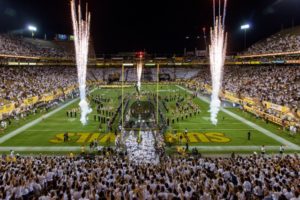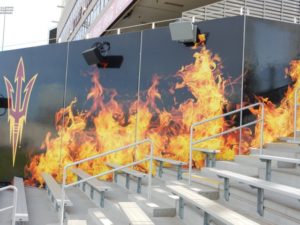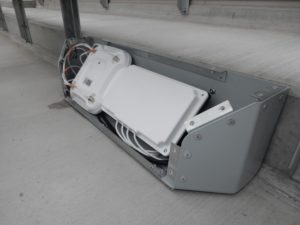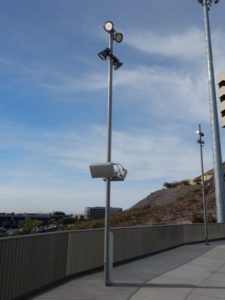In addition to expanded Wi-Fi and DAS for the stadium (a venue that includes classrooms, meeting rooms and retail outlets), ASU activated a virtual beacon trial. The university also joined up with Intel to explore how Internet of Things devices might yield better environmental information about the bowl, including acoustic data, Jay Steed, assistant vice president of IT operations, told Mobile Sports Report.
The university’s IT department understood that a richer fan experience for football and other events would require a robust network. Steed and his colleagues visited other venues like Levi’s Stadium, AT&T Stadium, Stanford and Texas A&M to get a better handle on different approaches to networking, applications and services.
Regardless, some sort of refresh was overdue. Wedged between two buttes in the southeastern Phoenix suburb of Tempe, the 71,000-seat Sun Devil Stadium was completed in 1958 and needed infrastructure and technology updates. Wi-Fi access was limited to point-of-sale systems and stadium suites; fans generally relied on a DAS network.
Time for an upgrade
Editor’s note: This profile is from our latest STADIUM TECH REPORT, the ONLY in-depth publication created specifically for the stadium technology professional and the stadium technology marketplace. Read about the Sacramento Kings’ new Golden 1 Center and the new Wi-Fi network for the Super Bowl in our report, which is available now for FREE DOWNLOAD from our site!
“The stadium needed a lot of facelifting, not just from a technology perspective but also for the fan experience, like ADA compliance and overall comfort,” Steed said. “We didn’t just want to rebuild a venue for six football games a year, but extend its availability to 365 days and make it a cornerstone and anchor for the whole campus.”
The reset included tearing out the lower bowl to “punch some new holes” — new entry points to the stadium — and to add conduits and cabling for the new 10-gigabit fiber backbone for the stadium. The network can be upgraded as needed to 40- and even 100-gigabit pipes, according to Steed.“We wanted to make sure it could support fans’ [connectivity needs] and all the facility’s operations with regard to video and StadiumVision, learning and education, and Pac-12 needs as well,” he said.
The overall stadium renovation was budgeted at $268 million; the technology upgrades will total about $8 million.
The university added 250 new DAS antennas. The vendor-neutral network includes AT&T, Verizon, Sprint and T-Mobile, which share 21 DAS sectors to keep cell service humming inside the stadium.
On the Wi-Fi side, ASU opted for Cisco’s access points. The networking vendor was already entrenched across the 642-acre campus; Steed and the IT department prefer the simplicity of a single-vendor network. Cisco helped with the hardware and RF engineering for Sun Devil Stadium. CenturyLink offered guidance on the networking and fiber pieces of the project, while Hunt-Sundt, a joint venture, was the contractor for most of the physical construction.
Wireless service for ‘The Inferno’
When the renovation is officially completed later in 2017 (most of the network is already live), there will be 1,100 APs in and around Sun Devil Stadium. The student sections, also known as The Inferno, get more APs and bandwidth since historical data has shown students to be the biggest bandwidth consumers in the stadium. Consequently, the ratio in the student sections is one AP to every 50 users; the rest of the bowl’s APs each handle about 75 users on average, Steed said.
ASU’s new Wi-Fi network was engineered to deliver 1.5 Mbps upstream and 3 Mbps downstream, but Steed said so far users are getting better performance – 8 Mbps up and 12 Mbps down. “We’re getting about 25 percent saturation,” he added. “Many users put their phones away during the games, but we see spikes at halftime and during commercial breaks.” Regardless, ASU continually monitors Wi-Fi and DAS usage and adjusts bandwidth as needed.Another big challenge is the desert climate – temperatures regularly soar into triple digits. With about 450 under-seat APs in the bowl, Steed and his team had to make sure the enclosures could withstand heat and didn’t obstruct the walkways. “We’ll see how well the electronics do, baking at 120 degrees six months out of the year,” he laughed.
ASU is also working with Intel, using the stadium’s APs as part of an Internet of Things trial. As Steed described it, IoT sensors work alongside stadium APs to measure temperature, noise, vibration and other environmental data. “We also look at lighting control and water distribution and flow,” he said.
Automating the control of environmental functions like heating, cooling, power usage and facilities management will help the university toward its goal of being carbon-neutral by 2025, Steed added. The trials are designed so that the technology can be expanded across the university, possibly for campus transportation kiosks or student concierge services. IoT devices could give students and visitors information about adjacent buildings or landmarks around campus.Separate but related, the university is also testing cloud-based, Bluetooth low energy (BLE) technology from Mist Systems. These “virtual beacons” use sensors attached to an AP to flag information or a point of interest for students or stadium visitors. “The virtualized beacon technology helps us understand where people are walking around and what they’re looking at in the stadium and elsewhere around campus,” Steed said.
They’re currently being tested in some of Sun Devil Stadium’s suites; Steed foresees expanding that to the student union to help guide people to meeting rooms, retail facilities or food vendors, for example.
Steed credited excellent communication and collaboration among the university’s athletic and IT departments and other players in the upgrade equation. “Our athletic director, Ray Anderson, brought the CIO and me into his office and really worked together with us,” he explained. “The biggest piece of our success was knowing that the AD supported our recommendations and brought us in as valued advisors.”











So will this produce a better football team??? Or will it lead to a championship??? I see increased ticket prices only!!!!